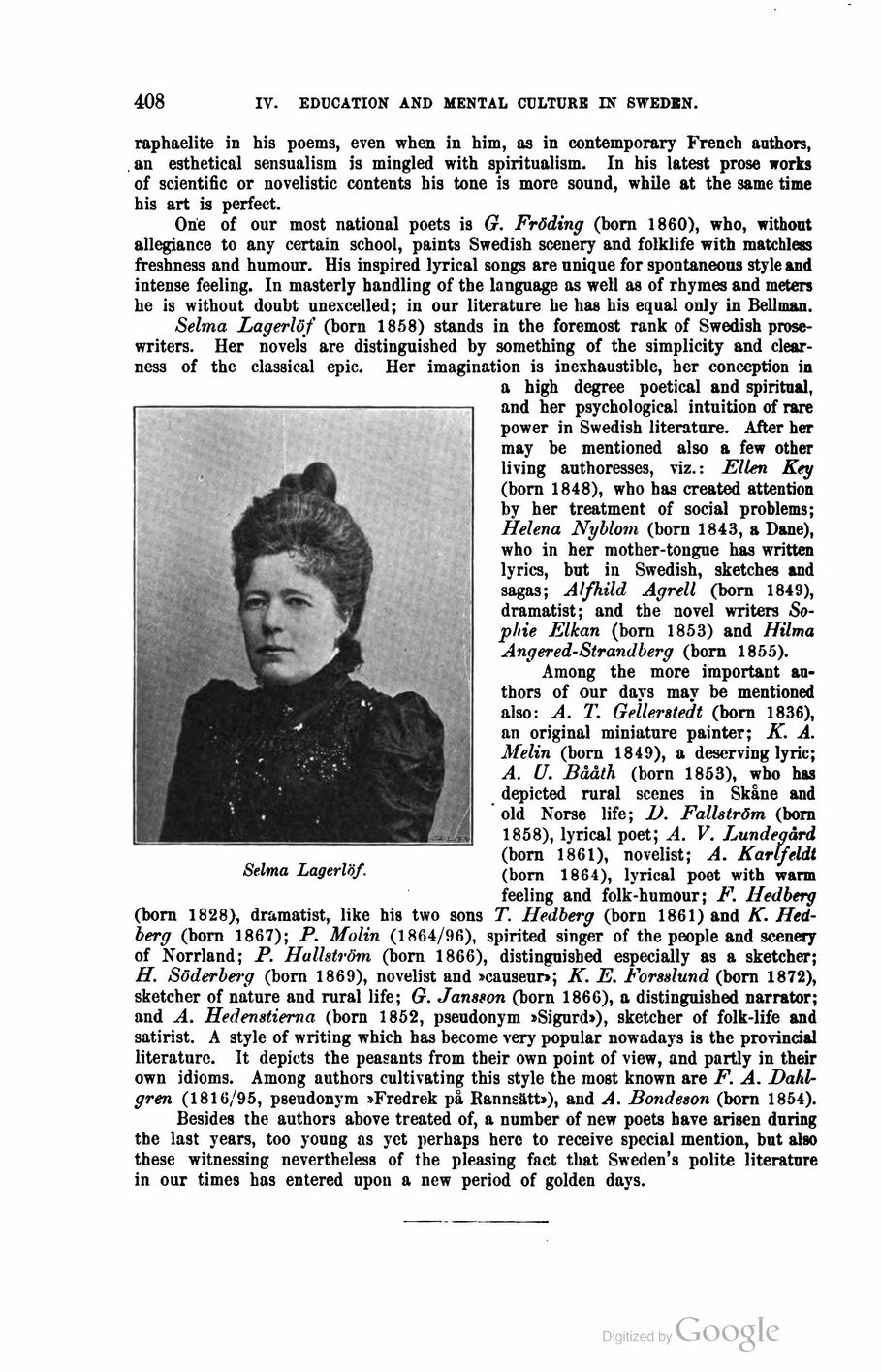
Full resolution (JPEG) - On this page / på denna sida - First part - IV. Education and Mental Culture - 8. Literature. By Lector R. Steffen, Ph. D., Örebro

<< prev. page << föreg. sida << >> nästa sida >> next page >>
Below is the raw OCR text
from the above scanned image.
Do you see an error? Proofread the page now!
Här nedan syns maskintolkade texten från faksimilbilden ovan.
Ser du något fel? Korrekturläs sidan nu!
This page has never been proofread. / Denna sida har aldrig korrekturlästs.
408 IV. EDUCATION AND MENTAL CULTURE IN SWEDEN.
raphaelite in his poems, even when in him, as in contemporary French authors,
an esthetical sensualism is mingled with spiritualism. In his latest prose works
of scientific or novelistic contents his tone is more sound, while at the same time
his art is perfect.
One of our most national poets is G. Fröding (born 1860), who, without
allegiance to any certain school, paints Swedish scenery and folklife with matchless
freshness and humour. His inspired lyrical songs are unique for spontaneous style and
intense feeling. In masterly handling of the language as well as of rhymes and meters
he is without doubt unexcelled; in our literature he has his equal only in Bellman.
Selma Lagerlöf (born 1858) stands in the foremost rank of Swedish
prose-writers. Her novels are distinguished by something of the simplicity and
clearness of the classical epic. Her imagination is inexhaustible, her conception in
a high degree poetical and spiritual,
and her psychological intuition of rare
power in Swedish literature. After her
may be mentioned also a few other
living authoresses, viz.: Ellen Key
(born 1848), who has created attention
by her treatment of social problems;
Helena Nyblom (born 1843, a Dane),
who in her mother-tongue has written
lyrics, but in Swedish, sketches and
sagas; Alfhild Agrell (born 1849),
dramatist; and the novel writers
So-phie Elkan (born 1853) and Hilma
Angered-Strand berg (born 1855).
Among the more important
authors of our days may be mentioned
also: A. T. Gellerstedt (born 1836),
an original miniature painter; K. A.
Melin (born 1849), a deserving lyric;
A. U. Bååth (born 1853), who has
depicted rural scenes in Skåne and
old Norse life; 1). Fallström (born
1858), lyrical poet; A. V. Lundegård
(born 1861), novelist; A. Karlfeldt
(born 1864), lyrical poet with warm
feeling and folk-humour; F. Hedberg
(born 1828), dramatist, like his two sons T. Hedberg (born 1861) and K.
Hedberg (born 1867); P. Molin (1864/96), spirited singer of the people and scenery
of Norrland; P. Hallström (born 1866), distinguished especially as a sketcher;
H. Söderberg (born 1869), novelist and »causeur»; K. E. Forsslund (born 1872),
sketcher of nature and rural life; G. Jansson (born 1866), a distinguished narrator;
and A. Hedenstiema (born 1852, pseudonym »Sigurd»), sketcher of folk-life and
satirist. A style of writing which has become very popular nowadays is the provincial
literature. It depicts the peasants from their own point of view, and partly in their
own idioms. Among authors cultivating this style the most known are F. A.
Dahlgren (1816/95, pseudonym »Fredrek på Rannsätt»), and A. Bondeson (born 1854).
Besides the authors above treated of, a number of new poets have arisen during
the last years, too young as yet perhaps here to receive special mention, but also
these witnessing nevertheless of the pleasing fact that Sweden’s polite literature
in our times has entered upon a new period of golden days.
Selma Lagerlöf.
<< prev. page << föreg. sida << >> nästa sida >> next page >>